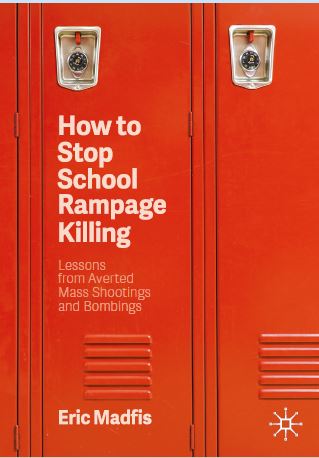Eric Madfis Explores Curbing School Violence in New Book
By studying situations where school violence was successfully avoided, school leaders can help prevent future violent acts, writes Madfis.
This story was originally published by UW News. Read the original here.

A new book by Eric Madfis of UW Tacoma argues that by studying situations where school violence was successfully avoided, school leaders can help prevent future violent acts.
Madfis is an associate professor of criminal justice whose research focuses on the causes and prevention of school violence, hate crimes and mass murder. His latest book, “How to Stop School Rampage Killing: Lessons from Averted Mass Shootings and Bombings,” was published this spring by Palgrave MacMillan.
In 2014, Madfis published “The Risk of School Rampage: Assessing and Preventing Threats of School Violence.” By the term “rampage,” Madfis says, he refers to multiple-victim attacks in school settings. “That may include violence using guns, bombs, or even knives. Certainly, there are many incidents of fatal single-victim school shootings that are not rampage attacks.”
Madfis answered some questions for UW Notebook about the book and the issue of school violence amid the turmoil of 2020.
Stopping gun-related school violence and lessening its impact, you write, “is a far more achievable goal than many believe it to be.” What causes your optimism?
Eric Madfis: Unfortunately, many of the common solutions proposed and implemented after school rampages are reactionary, short-sighted, and completely devoid of empirical support.
To try to rectify this and understand what actually prevents these incidents, I conducted in-depth interviews with school and police officials (such as teachers, administrators, counselors, security guards, and police officers) directly involved in averting potential rampage attacks. What I discovered goes against the grain of much of the conventional debate about school violence, but genuine solutions are out there.
A lot of the violence prevention practices currently employed in schools are not effective, especially to prevent or deter a mass shooting. For example, schools continue to install security cameras and armed security guards or police specifically to prevent school shootings, yet both of these measures were already in place at Columbine High School [in 1999] and did not deter or prevent those killings. Likewise, Minnesota’s Red Lake High School rampage killer [in 2005] walked right through the metal detector at his school’s front entrance. When a security officer tried to confront the student, he immediately shot and killed the man.
Zero tolerance school policies with mandatory suspensions or expulsions were widely adopted as early as 1993, yet they did nothing to curb the increased number of multiple-victim rampage shootings that have occurred across the country in the last two decades. Excluding students from school does nothing to resolve their problems or de-escalate conflicts, and such punishments have even exacerbated the existing isolation and accumulated anger of previous school shooters and served as a last straw culminating in their attack. In contrast, my research points to a number of more effective solutions and potential opportunities for intervention.
What does your research suggest?
E.M.: First, at least one person had some prior knowledge about the plans of perpetrators in the vast majority of school shooting incidents. In many cases, multiple students were aware of threats.

The most common mechanism by which these potentially devastating tragedies have been averted is through prospective school shooters revealing their violent intentions to others, who in turn disclosed this concerning information to school and police authorities. The issue is that students often do not come forward with this information due in part to a “code of silence” that discourages students from “ratting out” their peers. In contrast, there is plentiful research across a variety of disciplines which reveals that positive school climates where staff have forged inclusive communities as well as trusting and supportive relationships with students dramatically increase students’ likelihood of reporting threats.
This type of supportive school environment also lessens the chance that angry students would resort to school shootings in the first place, as marginalization, isolation and bullying often contribute to the cumulative strain experienced by most school rampage killers. Restorative discipline that resolves conflicts and reduces racial disproportionality in punishment has been shown to dramatically increase positive school climates and, accordingly, the willingness of students to intervene.
You write of your hope that through empirical research, districts can implement policies “which have been proven to effectively thwart these potentially tragic incidents” without stereotyping or sacrificing student rights in the process. What might be a couple of examples of such policies?
E.M.: Much of my research investigating averted incidents of school rampage attacks discovered that the proper utilization of threat assessment was often crucial in preventing mass killings from being carried out.
The threat assessment approach differs from other, more problematic forms of violence risk assessment and prediction currently used in schools. Threat assessment focuses upon the substantive analysis of existing threats rather than attempts to forecast the future behavior of people based on typical personality profiles, mental health issues, broad warning signs, or other aggregate data pertaining to individual or demographic characteristics.
Eric Madfis opinion piece in the Alabama publication AL.com, March 2019:
“Dear media stop using mass murderers’ pictures and names“
For example, students should not be targeted for scrutiny based on the fact that they like violent video games or wear black clothing. In contrast, the threat assessment approach argues that people who perpetrate acts of targeted violence lack a single homogeneous profile, but if a threat is made, then the evaluation of offenders’ backgrounds, behaviors and resources may aid in determining whether it is credible and/or likely to lead to violence.
Threat assessment involves three things: identifying student threats to commit a violent act; determining the seriousness of the threat; and developing intervention plans that protect potential victims and address the underlying problems or conflicts that fueled the threatening behavior. In the threat assessment approach, not all threats are equivalent —– how direct, detailed, developed and actionable the threat is helps to assess seriousness.
Depending on the determined level of concern, multidisciplinary threat assessment teams (including representatives from school administration, school-employed mental health professionals, and law enforcement) then develop and implement intervention strategies to manage the student’s behavior in ways that promote a safe, supportive teaching and learning environment, without unnecessarily excluding the student from the school.
Are there school districts or cities that have already reformed their policies in this way?
E.M.: Recent state legislation (HB 1216) mandated the use of threat assessment programming in all schools across the state of Washington starting in the fall of 2020, and this is a significant step in the right direction. Unfortunately, Washington state still has a long way to go to develop the type of systemwide restorative school practices present in places like Oakland, California, or Denver, Colorado.
With our country in turmoil over inequality and injustice, where do issues of school violence fit in the larger context?
E.M.: School violence and the response to it clearly demonstrate the ways in which injustice plays out in the United States. For example, school rampage shootings occur almost exclusively in predominantly white, rural and suburban communities, but schools across the county have typically responded to this threat with enhanced punishments and increased security, and the most extreme forms of this response (like metal detectors and random locker searches) have been adopted almost exclusively in urban schools with more diverse student populations which ultimately exacerbates inequality through disproportionate suspensions, expulsions, and even arrests for students of color.
One reaction to the recent spate of school rampage shootings has been to hire more school resource officers. My research found that, while resource officers can play a role in preventing shootings, simply having an officer in a school does not necessarily serve as a deterrent or mean that a school will not experience an attack. Many student plotters planned to merely kill the resource officer first, and many schools that have experienced a shooting already had such officers on campus.
In addition, data suggest that the presence of police officers on school campuses exacerbates the school-to-prison pipeline and makes schools more likely to address disciplinary issues though the justice system.
Some activists and scholars have long argued that the harms of police in schools outweigh the benefits; in the wake of public outcries over recent police violence, prominent school districts like Minneapolis, Denver and Portland have discontinued the use of school resource officers. This is a pretty dramatic change in the national discourse over a short period of time, and I am hopeful that the negative consequences of our overreliance on the securitization of schools will continue to be part of this conversation.



